第一天、WEB课程
web课程主要讲三部分内容
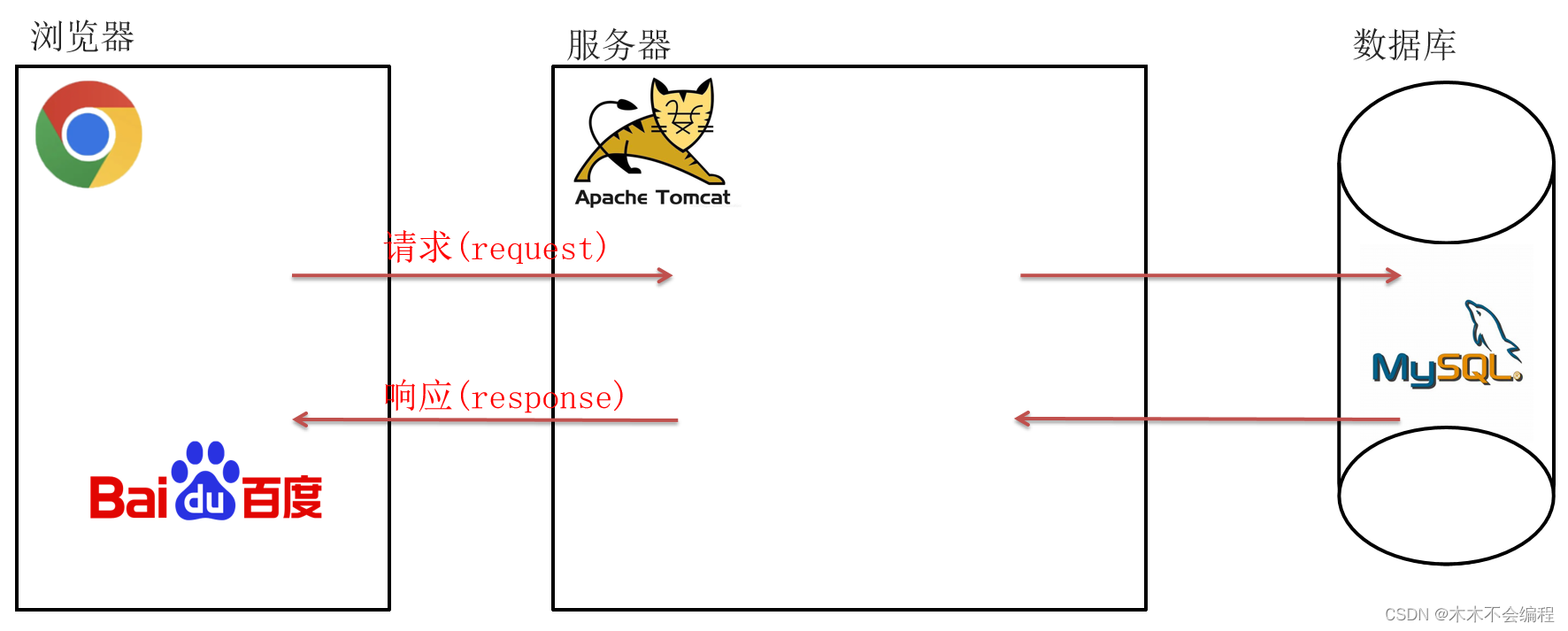
数据库
数据库介绍
什么是数据库
-
数据存储的仓库,其本质也是一个文件系统
-
数据库会按照特定的格式对数据进行存储,用户可以对数据库中的数据进行增加,修改,删除及查询操作。
数据库管理系统层次
数据库管理系统 (DataBase Management System,DBMS) 指一种操作和管理数据库的大型软件。
数据库管理系统的层次:
软件-->数据库-->数据表-->数据记录

常见的数据库管理系统
业界的数据库种类有很多,我们以后见到比较多的是MySQL和Oracle
* MySQL: 开源免费的数据库,小型的数据库。已经被Oracle公司收购了,MySQL6.x版本(商业、社区)也开始收费。 * Oracle:收费的大型数据库,Oracle公司的产品。 * DB2: IBM公司的数据库产品,收费的。 * SQLServer:MicroSoft公司收费的中型的数据库。C#、.net等语言常使用。
MySQL安装
系统修复
检测并添加你系统中mysql需要的一些底层类库

软件安装
将软件解压,然后把文件夹复制到
D:\dev(除C盘外任意盘除非只有一个C盘)结构如下(注意:目录不能有空格 不能有中文)
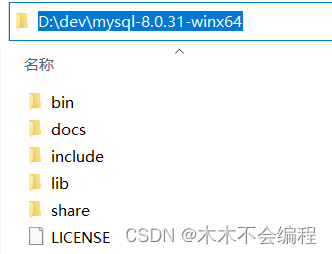
设置环境变量
新建系统变量,添加
MYSQL_HOME=mysql安装目录编辑环境变量,在path中添加
%MYSQL_HOME%/bin
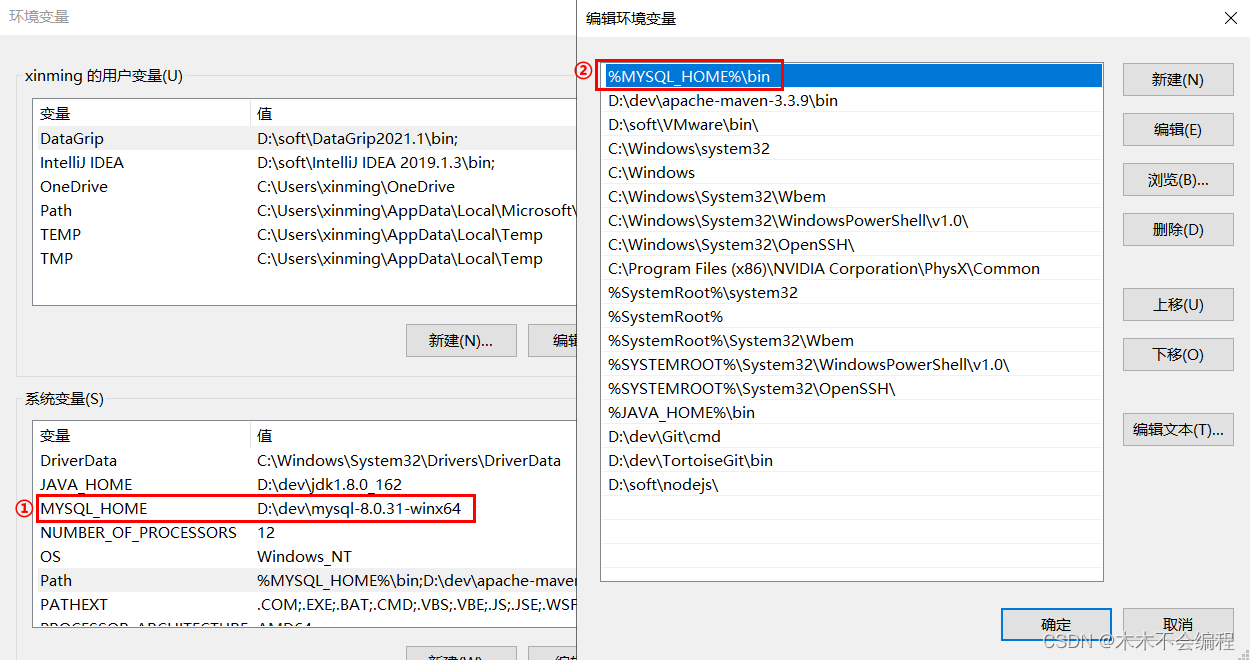
添加配置文件
在mysql的安装目录下创建配置文件
my.ini,然后将下面内容添加到文件中(直接复制粘贴,不要手写容易出错)
[mysqld]
# 设置3306端口
port=3306
# 允许最大连接数
max_connections=200
# 允许连接失败的次数
max_connect_errors=10
# 服务端使用的字符集默认为UTF8
character-set-server=utf8
# 创建新表时将使用的默认存储引擎
default-storage-engine=INNODB
# 默认使用mysql_native_password插件认证
default_authentication_plugin=mysql_native_password
# 配置时区
default-time_zone='+8:00'
[mysql]
# 设置mysql客户端默认字符集
default-character-set=utf8
[client]
# 设置mysql客户端连接服务端时默认使用的端口
port=3306
default-character-set=utf8创建服务并启动
以管理员身份CMD运行dos命令行,并执行下面命令
# 注意调整下面数据库配置文件的位置 mysqld --install mysql --defaults-file="D:\dev\mysql-8.0.31-winx64\my.ini" # 初始化 mysqld --initialize-insecure # 启动服务 net start mysql # 设置root用户的密码 mysqladmin -u root password root
停止并卸载mysql
如果你想卸载MySQL,也很简单。
点击开始菜单,输入cmd,选择 "命令提示符",选择右侧的 "以管理员身份运行"。

这两个命令用于卸载mysql服务,当需要重装mysql时再执行
net stop mysql mysqld --remove mysql
最后删除MySQL目录及相关的环境变量。
SQL介绍
什么是SQL
-
SQL全称Structured Query Language,翻译为:结构化查询语言
-
是用来操作数据库的一种语言,通过sql可以实现数据库、数据表、数据记录的增删改查
-
我们一般把增删改查称为CRUD:create创建、retrieve 检索、update 修改、delete删除
SQL分类
-
DDL(Data Definition Language) 数据定义语言:用来定义数据库,数据表
-
DML(Data Manipulation Language) 数据操作语言:用来对数据库中表的数据进行增删改
-
DQL(Data Query Language) 数据查询语言:用来对数据库中表的数据进行查询
-
DCL(Data Control Language) 数据控制语言:用来定义数据库的访问权限和安全级别以及创建用户
-
TCL(Transaction Control Language) 事务控制语言:用于控制数据库的事务操作
书写标准
-
SQL可以单行书写,也可以多行书写, 它以;结束一条SQL语句
-
在windows环境中SQL语句是不区分大小写的
-
在SQL中可以使用注释,一般有两种:单行注释
-- 注释内容和 多行注释/* 注释内容 */
数据库操作
连接数据库
-- 语法 mysql [-h 服务器地址 -P 端口号] -u用户名 -p密码 --实例 mysql -uroot -p
经典错误1: ERROR 2003 (HY000): Can't connect to MySQL server on 'localhost' (10061) 表示数据库服务停止了
经典错误2: ERROR 1045 (28000): Access denied for user 'root'@'localhost' (using password: YES) 表示你的用户名和密码不对
创建数据库
需求:创建一个名为db1的数据库
-- 语法 create database [IF NOT EXISTS] 数据库名; -- 实例 create database if not exists db1;
查询数据库
需求:查看所有数据数据库
-- 语法 show databases;
删除数据库
需求:删除名为db1的数据库
-- 语法 drop database [IF EXISTS] 数据库名; -- 实例 drop database if exists db1;
切换数据库
需求:查看正在使用的数据库
-- 语法 select database();
需求:切换正在使用的数据库为db1(db1必须存在)
-- 语法 use 数据库名; -- 实例 create database if not exists db1; use db1; select database();
数据库工具
连接数据库
打开连接窗口
点击idea左下角的图标
,在弹出框中选择Database
在idea右边侧边栏中选中Database
点击+号,然后选择Data Source中的MySQL
选择驱动版本
选择驱动版本,版本号选择8.0.13 Class选择com.mysql.cj.jdbc.Driver

建立连接
填写数据库服务地址、端口、账号、密码,点击测试,通过之后,点击ok保存连接

操作数据库
查看数据库
查看所有的数据库,相当于 show databases;
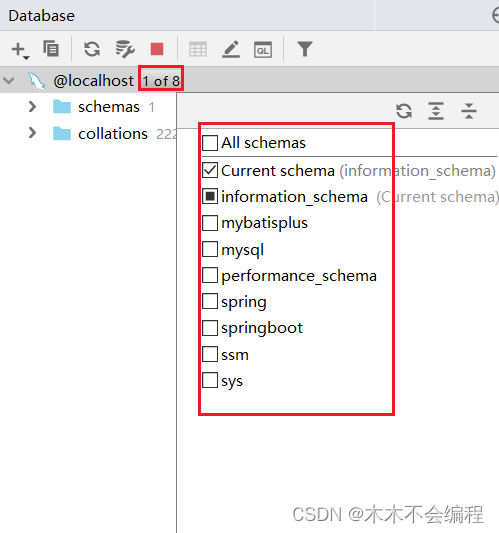
创建数据库
创建数据库,相当于create database 数据库名;
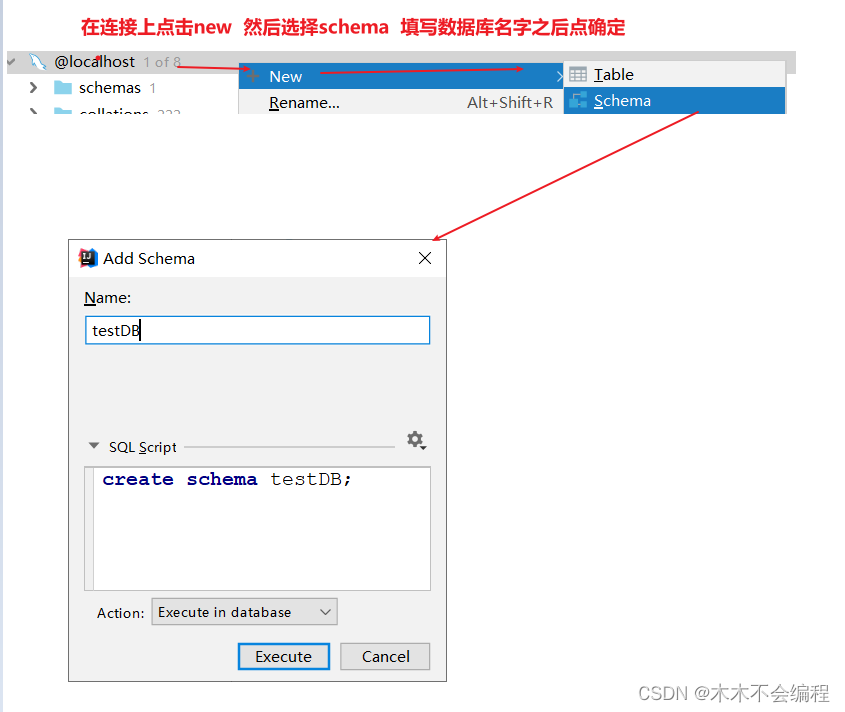
删除数据库
删除数据库,相当于 drop database 数据库名;
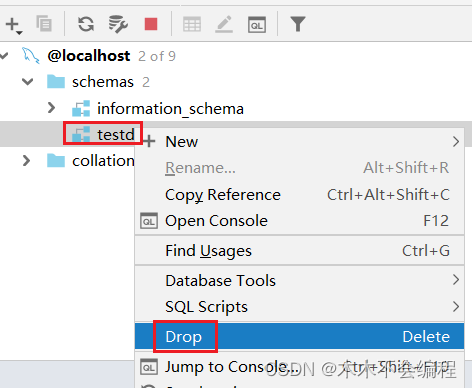
切换数据库
切换数据库,相当于use 数据库名

数据表操作
创建数据表
基本语法
需求:在db1中创建一张名为student1的数据表,表中字段的要求如下
id:标识,数字类型
name:姓名,字符串类型,长度限制最多30个字符
gender:性别,字符串类型,长度限制为1个字符
age:年龄,数值类型
birthday:生日,日期类型,格式YYYY-mm-dd
-- 语法create table 表名( 字段名1 字段类型1(字段长度) [ comment 字段1注释 ], -- 不是;号 字段名2 字段类型2(字段长度) [ comment 字段2注释 ], .... 字段名n 字段类型n(字段长度) [ comment 字段n注释 ]-- 最后一列后面是没有,的) [ comment 表注释 ];-- 实例 create table student1(id int comment '标识',name varchar(30) comment '姓名',gender varchar(1) comment '性别',age int comment '年龄',birthday date comment '生日' ) comment '学生表';
数据类型
下面列出了最常见的一些数据类型,详细的参照资料中的单独文档

需求:在db1中创建一张名为student2的数据表,要求跟student1一致,数据类型要更符合设计原则
-- 实例 create table student2(id int comment '标识',name varchar(30) comment '姓名',gender char(1) comment '性别', -- 性别,长度固定,采用char更合适age tinyint unsigned comment '年龄', -- 年龄,采用无符号的tinyint更合适birthday date comment '生日' ) comment '学生表';
数据约束
约束用于对表中的数据进行进一步的限制,一般作用在表中的字段上,用于保证数据的正确性。
约束种类有:主键约束、唯一约束、非空约束、默认值、外键约束。
需求:在db1中创建一张名为student3的数据表,表中字段的要求如下:
id:数字类型,
主键字段,并且数值自动增长name:字符串类型,长度限制最多30个字符,
要求姓名不能出现重复gender:字符串类型,长度限制为1个字符,
如果不插入,默认为男age:数值类型,
不能为空birthday:日期类型,格式YYYY-mm-dd
-- 语法create table 表名( 字段名1 字段类型1(字段长度) [ 约束 ] [ comment 字段1注释 ], -- 不是;号 字段名2 字段类型2(字段长度) [ 约束 ] [ comment 字段2注释 ], .... 字段名n 字段类型n(字段长度) [ 约束 ] [ comment 字段2注释 ] -- 最后一列后面是没有,的) [ comment 表注释 ];-- 实例 create table student3(id int primary key comment '标识',name varchar(30) unique comment '姓名',gender char(1) default '男' comment '性别',age tinyint unsigned not null comment '年龄',birthday date comment '生日' ) comment '学生表';
添加完约束之后,可以查询添加一些违法数据,观察报错
-- id重复会报错 Duplicate entry '1' for key 'PRIMARY' -- 姓名重复会报错 Duplicate entry '黑张三' for key 'name' -- age为null,会报错 Column 'age' cannot be null
查询数据表
查询当前数据库所有表:show tables
查询表结构:desc 表名
查询建表语句:show create table 表名
-- 1. 查看当前库中的所有数据表 show tables; -- 2. 查看student3表的表结构 desc student3; -- 3. 查看student3表的建表语句 show create table student3;
修改数据表
添加字段:alter table 表名 add 字段名 类型(长度)
修改字段类型:alter table 表名 modify 字段名 新数据类型(长度)
修改字段名和字段类型:alter table 表名 change 旧字段名 新字段名 类型 (长度)
删除字段:alter table 表名 drop column 字段名
修改表名: rename table 表名 to 新表名
-- 1. 修改student3表, 添加一列description 变长字符串类型,长度30 alter table student3 add description varchar(30); -- 2. 修改student3表 description列为定长字符串类型,长度40 alter table student3 modify description char(40); -- 3. 修改student3表 description列名为descr,变长字符串类型,长度20 alter table student3 change description descr varchar(20); -- 4. 删除student3表的descr列 alter table student3 drop column descr; -- 5. 修改student3表的名称为stu rename table student3 to stu;
删除数据表
删除表:drop table [ if exists ] 表名
-- 删除stu表 drop table stu;
注意事项
-
在删除表时,表中的全部数据也会被删除
表设计案例
需求:参考资料中提供的《智能学习辅助系统》页面原型,设计员工管理模块的表结构(暂不考虑所属部门字段)
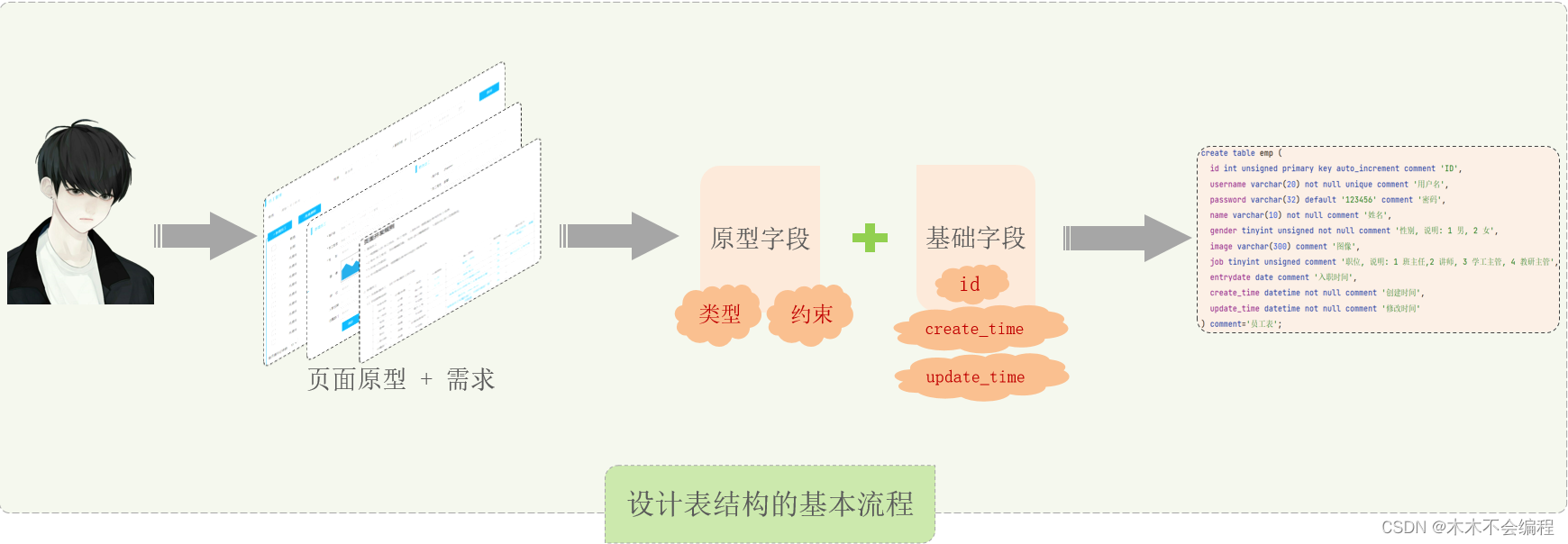
drop table if exists tb_emp; create table tb_emp(id int primary key auto_increment comment '主键ID',username varchar(20) unique not null comment '用户名',password varchar(32) default '123456' null comment '密码',name varchar(10) not null comment '姓名',gender tinyint unsigned not null comment '性别, 1 男, 2 女',image varchar(300) null comment '图像url',job tinyint unsigned null comment '职位, 1 班主任 , 2 讲师 , 3 学工主管, 4 教研主管',entrydate date null comment '入职日期',create_time datetime not null comment '创建时间',update_time datetime not null comment '修改时间' ) comment '员工表';
增删改数据
DML
-
DML英文全称是Data Manipulation Language(数据操作语言),用来对数据库中表的数据记录进行增、删、改操作
插入数据
指定字段添加数据:insert into 表名 (字段名1, 字段名2) values (值1, 值2)
全部字段添加数据:insert into 表名 values (值1, 值2, ...)
-- 1. 为 tb_emp 表的 username, name, gender, create_time, update_time 字段插入值
insert into tb_emp(username, name, gender, create_time, update_time) values ('zhangsan', '张三', 1, now(), now());
-- 2. 为 tb_emp 表的 所有字段插入值
insert into tb_emp(id, username, password, name, gender, image, job, entrydate, create_time, update_time)values (null, 'lisi', 'admin', '李四', 0, '1.jpg', 1, '2011-01-01', now(), now());
insert into tb_emp values (null, 'wangwu', '123', '王五', 0, '1.jpg', 1, '2011-01-01', now(), now());
-- 注意 1. 插入数据时,指定的字段顺序需要与值的顺序是一一对应的2. 字符串和日期型数据应该包含在引号中
批量添加数据(指定字段):insert into 表名 (字段名1, 字段名2) values (值1, 值2), (值1, 值2)
批量添加数据(全部字段):insert into 表名 values (值1, 值2, ...), (值1, 值2, ...)
-- 3. 批量为 为 tb_emp 表的 username , name , gender, create_time, update_time 字段插入数据
insert into tb_emp(username, name, gender, create_time, update_time)values ('zhangsan1', '张三1', 1, now(), now()),('zhangsan2', '张三2', 1, now(), now());
注意事项
-
插入数据时,指定的字段顺序需要与值的顺序是一一对应的。
-
字符串和日期型数据应该包含在引号中。
-
插入的数据大小,应该在字段的规定范围内。
修改数据
修改数据
update 表名 set 字段名1 = 值1 , 字段名2 = 值2 , .... [ where 条件 ]
注意事项
修改语句的条件可以有,也可以没有,如果没有条件,则会修改整张表的所有数据
-- 1. 将 tb_emp 表的所有员工的入职日期更新为'2010-01-01' update tb_emp set entrydate = '2010-01-01'; -- 2. 将 tb_emp 表的ID为1员工 姓名name字段更新为'黑马' update tb_emp set name = '黑马' where id = 1; -- 3. 将 tb_emp 表的ID为1员工 姓名name字段更新为'传智',入职日期更新为'2022-01-01' update tb_emp set name = '传智',entrydate = '2022-01-01' where id = 1; -- 注意 如果idea不让修改所有数据就在where后面加一个1=1 例如: update tb_emp set entrydate = '2010-01-01' where 1=1;修改语句中如果不加条件,则将所有数据都会被修改!
删除数据
删除数据
delete from 表名 [ where 条件 ]
注意事项
DELETE 语句的条件可以有,也可以没有,如果没有条件,则会删除整张表的所有数据。
DELETE 语句不能删除某一个字段的值(如果要操作,可以使用UPDATE,将该字段的值置为NULL)。
-- 1. 删除 tb_emp 表中ID为1的员工 delete from tb_emp where id = 1; -- 2. 删除 tb_emp 表中的所有员工 delete from tb_emp; -- 注意如果在idea中不让删除所有 就在where后面加一个 1=1 例如:delete from tb_emp where 1=1;删除语句中如果不加条件,则将所有数据都会被删除!
小结
-- 增加 insert into 表名 values(值1,值2...) -- 修改 update 表名 set 列1=值1,列2=值2 [where 条件] -- 删除 delete from 表名 [where 条件]
查询数据
创建数据库,使用下面sql创建数据
-- 员工管理(带约束) drop table if exists tb_emp; create table tb_emp (id int unsigned primary key auto_increment comment 'ID',username varchar(20) not null unique comment '用户名',password varchar(32) default '123456' comment '密码',name varchar(10) not null comment '姓名',gender tinyint unsigned not null comment '性别, 说明: 1 男, 2 女',image varchar(300) comment '图像',job tinyint unsigned comment '职位, 说明: 1 班主任,2 讲师, 3 学工主管, 4 教研主管',entrydate date comment '入职时间',create_time datetime not null comment '创建时间',update_time datetime not null comment '修改时间' ) comment '员工表'; -- 准备测试数据 INSERT INTO tb_emp (id, username, password, name, gender, image, job, entrydate, create_time, update_time) VALUES(1, 'jinyong', '123456', '金庸', 1, '1.jpg', 4, '2000-01-01', '2022-10-27 16:35:33', '2022-10-27 16:35:35'),(2, 'zhangwuji', '123456', '张无忌', 1, '2.jpg', 2, '2015-01-01', '2022-10-27 16:35:33', '2022-10-27 16:35:37'),(3, 'yangxiao', '123456', '杨逍', 1, '3.jpg', 2, '2008-05-01', '2022-10-27 16:35:33', '2022-10-27 16:35:39'),(4, 'weiyixiao', '123456', '韦一笑', 1, '4.jpg', 2, '2007-01-01', '2022-10-27 16:35:33', '2022-10-27 16:35:41'),(5, 'changyuchun', '123456', '常遇春', 1, '5.jpg', 2, '2012-12-05', '2022-10-27 16:35:33', '2022-10-27 16:35:43'),(6, 'xiaozhao', '123456', '小昭', 2, '6.jpg', 3, '2013-09-05', '2022-10-27 16:35:33', '2022-10-27 16:35:45'),(7, 'jixiaofu', '123456', '纪晓芙', 2, '7.jpg', 1, '2005-08-01', '2022-10-27 16:35:33', '2022-10-27 16:35:47'),(8, 'zhouzhiruo', '123456', '周芷若', 2, '8.jpg', 1, '2014-11-09', '2022-10-27 16:35:33', '2022-10-27 16:35:49'),(9, 'dingminjun', '123456', '丁敏君', 2, '9.jpg', 1, '2011-03-11', '2022-10-27 16:35:33', '2022-10-27 16:35:51'),(10, 'zhaomin', '123456', '赵敏', 2, '10.jpg', 1, '2013-09-05', '2022-10-27 16:35:33', '2022-10-27 16:35:53'),(11, 'luzhangke', '123456', '鹿杖客', 1, '11.jpg', 2, '2007-02-01', '2022-10-27 16:35:33', '2022-10-27 16:35:55'),(12, 'hebiweng', '123456', '鹤笔翁', 1, '12.jpg', 2, '2008-08-18', '2022-10-27 16:35:33', '2022-10-27 16:35:57'),(13, 'fangdongbai', '123456', '方东白', 1, '13.jpg', 1, '2012-11-01', '2022-10-27 16:35:33', '2022-10-27 16:35:59'),(14, 'zhangsanfeng', '123456', '张三丰', 1, '14.jpg', 2, '2002-08-01', '2022-10-27 16:35:33', '2022-10-27 16:36:01'),(15, 'yulianzhou', '123456', '俞莲舟', 1, '15.jpg', 2, '2011-05-01', '2022-10-27 16:35:33', '2022-10-27 16:36:03'),(16, 'songyuanqiao', '123456', '宋远桥', 1, '16.jpg', 2, '2010-01-01', '2022-10-27 16:35:33', '2022-10-27 16:36:05'),(17, 'chenyouliang', '12345678', '陈友谅', 1, '17.jpg', null, '2015-03-21', '2022-10-27 16:35:33', '2022-10-27 16:36:07'),(18, 'zhang1', '123456', '张一', 1, '2.jpg', 2, '2015-01-01', '2022-10-27 16:35:33', '2022-10-27 16:36:09'),(19, 'zhang2', '123456', '张二', 1, '2.jpg', 2, '2012-01-01', '2022-10-27 16:35:33', '2022-10-27 16:36:11'),(20, 'zhang3', '123456', '张三', 1, '2.jpg', 2, '2018-01-01', '2022-10-27 16:35:33', '2022-10-27 16:36:13'),(21, 'zhang4', '123456', '张四', 1, '2.jpg', 2, '2015-01-01', '2022-10-27 16:35:33', '2022-10-27 16:36:15'),(22, 'zhang5', '123456', '张五', 1, '2.jpg', 2, '2016-01-01', '2022-10-27 16:35:33', '2022-10-27 16:36:17'),(23, 'zhang6', '123456', '张六', 1, '2.jpg', 2, '2012-01-01', '2022-10-27 16:35:33', '2022-10-27 16:36:19'),(24, 'zhang7', '123456', '张七', 1, '2.jpg', 2, '2006-01-01', '2022-10-27 16:35:33', '2022-10-27 16:36:21'),(25, 'zhang8', '123456', '张八', 1, '2.jpg', 2, '2002-01-01', '2022-10-27 16:35:33', '2022-10-27 16:36:23'),(26, 'zhang9', '123456', '张九', 1, '2.jpg', 2, '2011-01-01', '2022-10-27 16:35:33', '2022-10-27 16:36:25'),(27, 'zhang10', '123456', '张十', 1, '2.jpg', 2, '2004-01-01', '2022-10-27 16:35:33', '2022-10-27 16:36:27'),(28, 'zhang11', '123456', '张十一', 1, '2.jpg', 2, '2007-01-01', '2022-10-27 16:35:33', '2022-10-27 16:36:29'),(29, 'zhang12', '123456', '张十二', 1, '2.jpg', 2, '2020-01-01', '2022-10-27 16:35:33', '2022-10-27 16:36:31');
基本查询
DQL
-
DQL英文全称是Data Query Language(数据查询语言),用来查询数据库表中的记录
-
关键字:SELECT
查询指定字段:select 字段1, 字段2, 字段3 from 表名
查询所有字段:select * from 表名
设置别名:select 字段1 [ as 别名1 ] , 字段2 [ as 别名2 ] from 表名
去除重复记录:select distinct 字段列表 from 表名
注意事项: 号代表查询所有字段,在实际开发中尽量少用(不直观、影响效率)
-- 1. 查询指定字段 name,entrydate 并返回 select name,entrydate from tb_emp; -- 2. 查询返回所有字段 select * from tb_emp; -- 3. 查询所有员工的 name,entrydate, 并起别名(姓名、入职日期) --- as 关键字可以省略 select name as '姓名' ,entrydate as '入职日期' from tb_emp; select name '姓名' ,entrydate '入职日期' from tb_emp; -- 4. 查询员工有哪几种职位(不要重复) select distinct job from tb_emp;
条件查询
条件查询
select 字段列表 from 表名
where 条件列表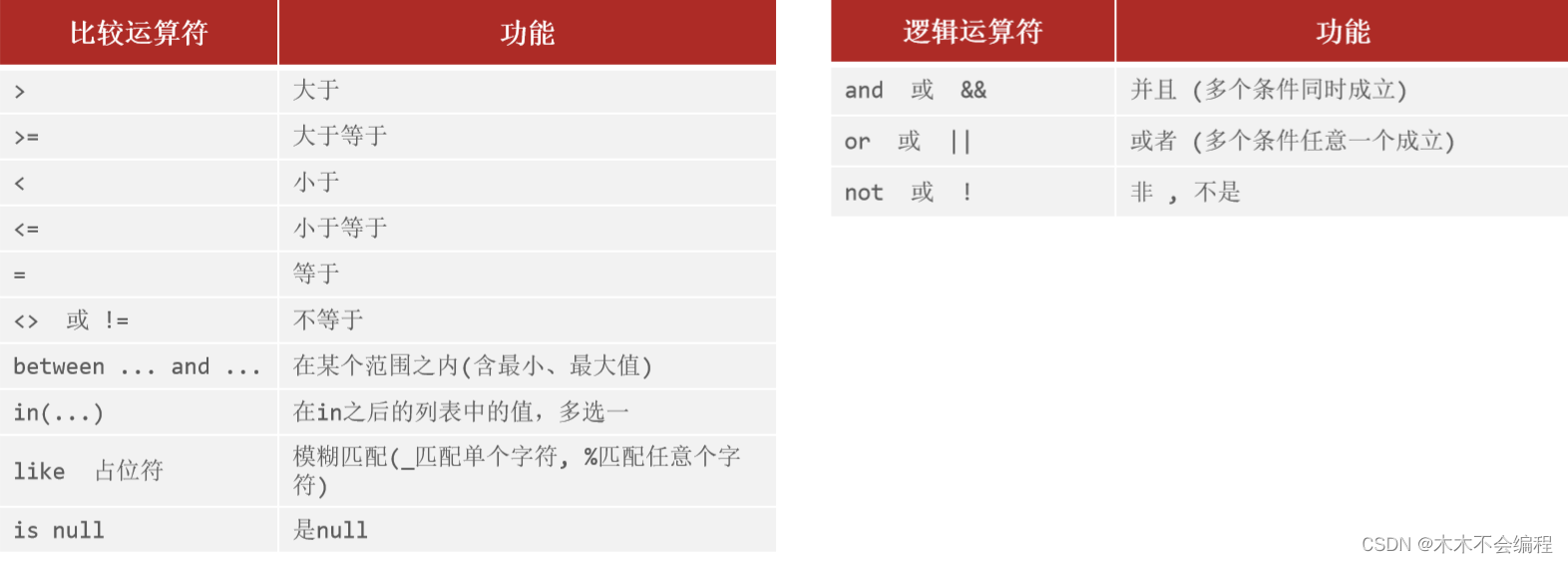
-- 1-1. 查询 姓名 为 杨逍 的员工 select * from tb_emp where name = '杨逍'; -- 1-2. 查询在 id小于等于5 的员工信息 select * from tb_emp where id <=5; -- 1-3. 查询 密码不等于 '123456' 的员工信息 select * from tb_emp where password != '123456'; -- 1-4. 查询 没有分配职位 的员工信息 select * from tb_emp where job is null; -- 1-5. 查询 有职位 的员工信息 select * from tb_emp where job is not null; -- 2-1. 查询 id<=5 并且 job=2 的员工信息 select * from tb_emp where id <=5 and job = 2; -- 2-1. 查询 id<=5 或者 job=2 的员工信息 select * from tb_emp where id <=5 or job = 2; -- 3-1. 查询入职日期 在 '2000-01-01' (包含) 到 '2010-01-01'(包含) 之间的员工信息 select * from tb_emp where entrydate >= '2000-01-01' and entrydate <= '2010-01-01'; select * from tb_emp where entrydate between '2000-01-01' and '2010-01-01'; -- 3-2. 查询职位是 2 (讲师), 3 (学工主管), 4 (教研主管) 的员工信息 select * from tb_emp where job = 2 or job = 3 or job = 4; select * from tb_emp where job in (2,3,4); -- 4-1. 查询姓 '张' 的员工信息 select * from tb_emp where name like '张%'; -- 4-2. 查询姓名中包含 '三' 的员工信息 select * from tb_emp where name like '%三%'; -- 4-3. 查询姓'张',并且姓名为三个字的员工信息 select * from tb_emp where name like '张__';
聚合函数
聚合函数
将一列数据作为一个整体,进行纵向计算,语法为: select
聚合函数(字段名)from 表名注意事项:
null值不参与所有聚合函数运算。
统计数量可以使用:count() count(字段) count(常量),推荐使用count()
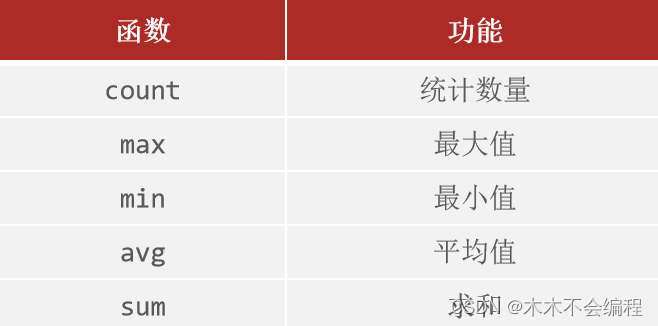
-- 1. 统计该企业员工数量 select count(*) from tb_emp; select count(id) from tb_emp; -- 不包含空值的列 select count(1) from tb_emp; -- 任意数字 -- 2. 统计该企业最早入职的员工的入职日期 select min(entrydate) from tb_emp; -- 3. 统计该企业最迟入职的员工的入职日期 select max(entrydate) from tb_emp; -- 4. 统计该企业员工ID的平均值 select avg(id) from tb_emp; -- 5. 统计该企业员工的ID之和 select sum(id) from tb_emp;
分组过滤
分组过滤
select 分组字段,聚合函数() from 表名
group by 分组字段名having 分组后过滤条件where与having区别
执行时机不同:where是分组之前进行过滤,不满足where条件,不参与分组;而having是分组之后对结果进行过滤
判断条件不同:where不能对聚合函数进行判断,而having可以
注意事项
分组之后,查询的字段一般为聚合函数和分组字段,查询其他字段无任何意义
执行顺序: where > 聚合函数 > having
-- 1. 根据性别分组, 统计男性和女性员工的数量 select gender,count(1) from tb_emp group by gender; -- 2. 先查询入职时间在 '2015-01-01' (包含) 以前的员工 select * from tb_emp where entrydate <= '2015-01-01'; -- 3. 先查询入职时间在 '2015-01-01' (包含) 以前的员工,并对结果根据职位分组 select job,count(1) from tb_emp where entrydate <= '2015-01-01' group by job; -- 4. 先查询入职时间在 '2015-01-01' (包含) 以前的员工,并对结果根据职位分组,获取员工数量大于等于2的职位 select job,count(1) from tb_emp where entrydate <= '2015-01-01' group by job having count(1) > 2;
排序
排序
select 字段列表 from 表名 order
by 字段1 排序方式1 , 字段2 排序方式2ASC:升序(默认值)
DESC:降序
注意事项
如果是多字段排序,当第一个字段值相同时,才会根据第二个字段进行排序
-- 1. 根据入职时间,对员工进行降序排序 select * from tb_emp order by entrydate desc; -- 2. 根据入职时间,对员工进行升序排序 select * from tb_emp order by entrydate asc; -- 3. 根据入职时间对公司的员工进行升序排序,入职时间相同再按照ID进行降序排序 select * from tb_emp order by entrydate asc, id desc;
分页
分页:
select 字段列表 from 表名
limit 起始索引, 查询记录数注意事项
起始索引从0开始,起始索引 = (查询页码 - 1)* 每页显示记录数。
分页查询是数据库的方言,不同的数据库有不同的实现,MySQL中是LIMIT。
如果查询的是第一页数据,起始索引可以省略,直接简写为 limit 10。
-- 1. 查询第1页员工数据, 每页展示5条记录 select * from tb_emp limit 0,5; -- 2. 查询第2页员工数据, 每页展示5条记录 select * from tb_emp limit 5,5; -- 3. 查询第3页员工数据, 每页展示5条记录 select * from tb_emp limit 10,5; -- 4. 查询第4页员工数据, 每页展示5条记录 select * from tb_emp limit 15,5;
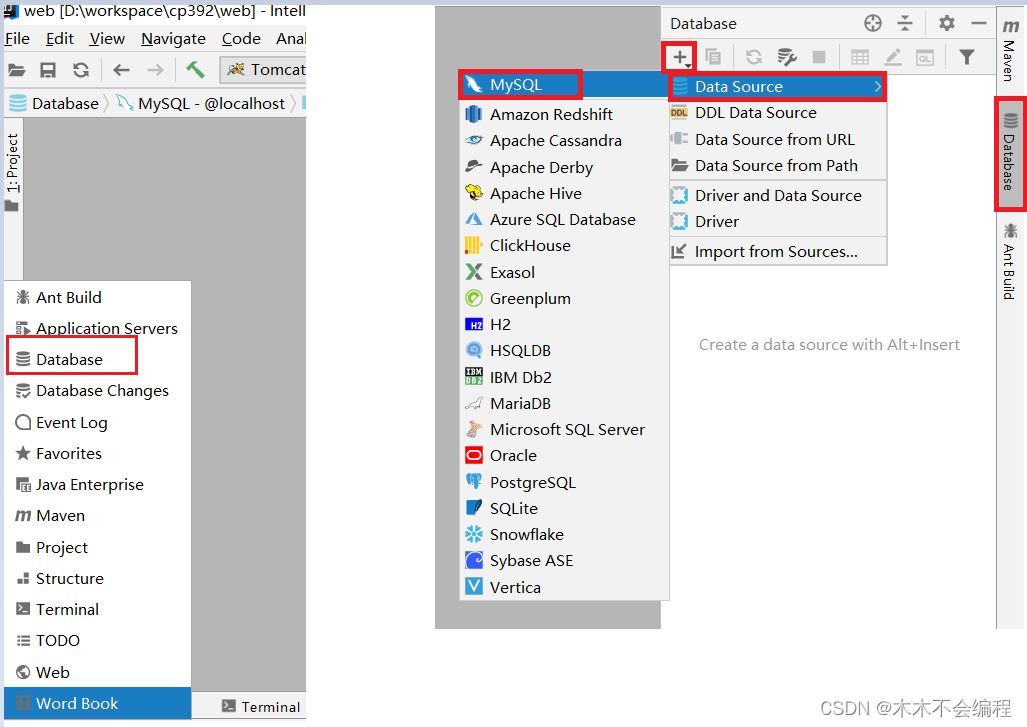







)







)



)
